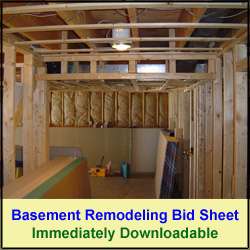Key Steps for Removing and Preventing Mold and Mildew in your Home
By Mark J. Donovan
|
|
Mold and mildew on your home’s interior or exterior walls is a real problem. Besides making your homes’ walls look dirty, mold and mildew can also lead to health problems for the home’s inhabitants. Consequently it is important to remove mold and mildew build up as soon as you see it.
Eliminating mold and mildew requires extensive elbow grease and a solution of 1 part bleach, 3 parts water and a small amount of Trisodium Phosphate (PST) (approximately 1 cup per 7 quarts of the water/bleach solution). Trisodium phosphate has some environmental regulations, so you should check with your local paint store to see if it is okay to use in your area. |
The paint dealer should be able to offer an alternative to PST, if it is not allowed in your area.
After mixing up the solution in a bucket, thoroughly wipe down the walls with this solution using a rag, and then rinsed off with clean water. If you plan on repainting the walls let the walls dry for several days before repainting. Also, make sure the area is dry. You may want to consider using a dehumidifier in the room to help with the drying out process.
Mold and mildew typically form in a home due to two reasons, high moisture levels within the home, and insufficient airflow. Unfortunately the downside of today’s new home construction is that they are well built and air tight. This air tightness, however can lead to a buildup of moisture levels in the home which can then lead to the formation of mold and mildew.
Also, if your home has gutters, make sure the drain spouts properly divert rain water run-off away from the home. Finally, consider installing a sump pump or dehumidifier in your basement to remove water from the basement. Also, if your home has an earth crawl space for a basement, install a layer of plastic on the floor of the crawl space and cover it with crushed stone.
| Also, while in the basement cover all supply line pipes with insulated pipe foam. If you see green stains on your basement floor, underneath the copper supply lines, this is a sure sign that you have condensation occurring on the supply lines during hot summer days. Also make sure the central air conditioning duct work is insulated. As warm moist air comes in contact with these supply lines and/or duct work, condensation can form on them. The condensation then eventually drips to the basement floor and forms puddles.
Another area to examine for high moisture levels is in the bathrooms and laundry rooms of the home. Make sure that the bathroom and dryer vents are properly vented to the outside of the home. |
|
If you are building a new home or an addition to the home, make sure you insulate it properly to prevent the threat of mold and mildew.
If you live in an area with high summer humidity and cold winters, use insulation with a vapor barrier on your exterior walls. The vapor barrier should be applied on the warm side of the wall (towards the inside of the home). This will prevent moisture from wicking onto the insulation during the winter months.
With this list of preventative steps you should be able to prevent the re-occurrence of mold and mildew within your home, and/or the prevention of it all together.
For more help on Basement Additions, see HomeAdditionPlus.com’s Basement Remodeling Bid sheet. The Basement Remodeling Bid Sheet will help ensure that your hire the right contractor so that your basement remodeling project is done correctly and you get the project finished on time and budget.
Related Information
- How to Prevent a Flooded Basement this Spring
- How to Prevent a Flooded Basement When on Vacation
- How to Install on Your Own a Basement Sump Pump
Get Free Basement Waterproofing Price Quotes with No Obligation!
Fill out our 3-5 minute quick and easy form, and receive a free price quote on waterproofing from one of our prescreened and licensed waterproofing contractors. This process is free and there is no obligation to continue once you receive your waterproofing price estimate.


